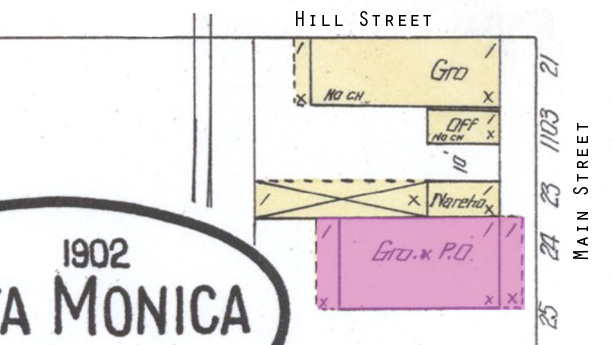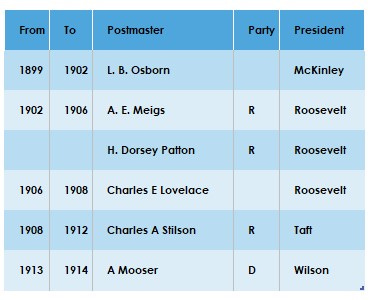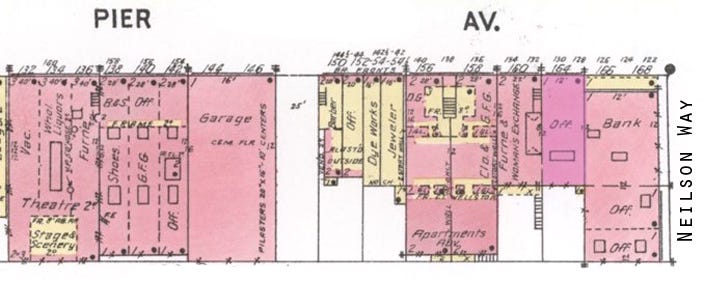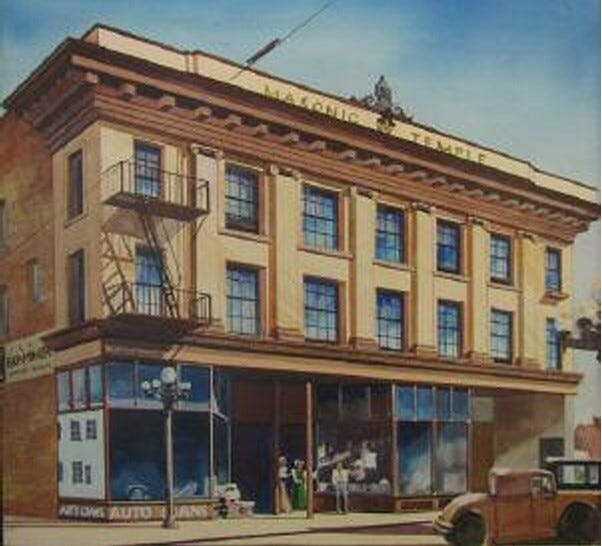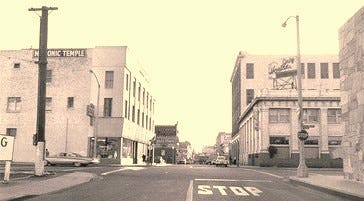From 1899 to 1914, Ocean Park, a neighborhood of Santa Monica, has its own post office - the only instance of two separate post offices being established within a single municipality. This results in a long-running dispute between interests in North and South Santa Monica.
The Santa Monica post office (Santa Monica, CA) opens in 1875.1
In the 1890s, it is inconvenient to travel from Ocean Park to Santa Monica. L.B. Osborn (1843 - 1904),2 a grocer on Main St. near Hill St, volunteers to collect his customers’ mail at the Santa Monica post office and hold it at his store. As the Ocean Park population grows, this becomes burdensome. With the help3 of Abbot Kinney, Osborn is appointed4 postmaster in July 1899, and his store5 is recognized as the Ocean Park post office (Ocean Park, CA).
The Post Office Department (1872 - 1971) admits that this is a mistake. The Ocean Park post office should have been designated as a substation of the main Santa Monica post office. Osborn should have been made superintendent, instead of postmaster.
By 1902, Osborn’s grocery business has grown; he re-models his store, but he is in poor health - he wants out. A.E. Meigs (1830 - 1921),6 an old soldier and recent Ocean Park arrival with previous post office experience, is appointed postmaster. The post office is moved from Osborn’s grocery to a space directly across Main St.
The post office business grows and Ocean Park advances to a post office of the 3rd Class. Meigs’ pay increases from $1,100 to $1,500 per annum. Meigs seeks better accommodations, and in 1903, A.R. Fraser and G.M. Jones build a sole purpose, 1 story with a single 60 ft x 20 ft room, brick post office building on Pier Ave next to the Ocean Park Bank. The post office moves to Pier Ave from Main St - several Main St. businesses follow.
In 1904, to the south of Santa Monica, the City of Ocean Park (Venice) incorporates and gets its own post office (and postmaster). However, as two post offices in the state cannot have the same name, the new post office is named Venice, CA (not Ocean Park, CA).7 There are now 3 post offices (Santa Monica, Ocean Park, and Venice) in close proximity. For cost-saving reasons, the Post Office Department will only agree to provide free delivery of the mail,8 if the 3 post offices are consolidated into one main post office (with one postmaster) and two substations (each with a superintendent). The dispute over post office consolidation will go on for the next 10 years - with no free delivery of the mail in the interim.9
In 1905, despite vigorous protests,10 the Ocean Park post office again moves - from Pier Ave to a space in A.R. Fraser’s new three-story brick Masonic Temple building at 158 Marine St. on the corner of Neilson Way.
In 1905, Dorsey Patton (1856 -1906),11 trained in the Chicago school of politics, is appointed postmaster. For a variety of reasons, Patton does not take up the position12 and A.E. Meigs hangs on. Meigs is widely regarded as gruff, unaccommodating, and incompetent.
In 1906, Charles E. Lovelace (1870 - 1926),13 editor of the Ocean Park Journal, is appointed postmaster (which now pays $2,300 per annum) – ousting A.E. Meigs. In 1907, following an unannounced inspection by the Post Office Department, Lovelace is arrested for embezzlement of post office funds (he has been losing at high-stakes poker games and the post office account is a few thousand dollars short). He is sentenced to 3 years in San Quentin.
In 1908, 64-year-old local real estate man, Charles A. Stilson (1844 - 1915)14 is appointed Ocean Park postmaster.
In 1913, A. Mooser (1842 - 1931),15 a 72-year-old retired merchant and Democrat, is appointed postmaster by the new Woodrow Wilson administration. However, Mooser serves only a few months as the Post Office Department finally gets its way. After April 30, 1914, Santa Monica is the main post office, and the post office on Marine St. only a substation (the postal address Ocean Park, CA is gone). Santa Monica postmaster, W. S. Vawter is given credit for pushing the changes through and for finally obtaining free delivery of mail for Santa Monica. Mooser’s postmaster $2,600 per annum pay is reduced to $1,300 as superintendent. Mooser retires.
In 1915, the Ocean Park substation of the Santa Monica post office moves to 2818 Main St. When that building is demolished in the 1926 Main St widening, the Ocean Park substation returns to the Masonic Temple building.
With the 1964 Ocean Park re-development project, the Masonic Temple building is demolished, and a new post office substation is incorporated into The Shores development. The Post Office Department is abolished in 1971, and its functions transferred to the U.S. Postal Service (USPS).
Leonard Beattie Osborn (1843 – 1904). Born in Ohio, he is a Civil War veteran. In 1867, Osborn marries Achsah D Murray (1847 - 1915) in Ohio. He comes to CA in 1881, and then to Ocean Park in 1894. Osborn is Kinney & Ryan’s on-site real estate agent for the Santa Monica Tract and he has a grocery store on Main St. just south of Hill St. (2708 Main St). In 1899, Osborn is appointed the first postmaster of the Ocean Park, CA post office. Osborn arranges with A.N. Archer to carry the mail between the Ocean Park and the Santa Monica Post Offices.
In 1899, a request for a post office in Ocean Park is sent to the Post Office Department. The request is recommended by postal inspector M.H. Flint of Los Angeles. A form is sent to L.B. Osborne, which he fills out. The bottom of the form requires a certification from the nearest Post Office that the statements made are correct. Santa Monica Postmaster George B. Dexter refuses to certify the statements. Dexter obtained his appointment due to influence from the Jones people, who have no great holdings in Ocean Park.
Based on gross receipts, post offices are divided into 4 classes. The post office class determines the postmaster’s compensation. From 1836 to 1971, postmasters at Class 1, 2, and 3 post offices are appointed by the President. Postmaster appointments are highly sought after, and provide the main source of political patronage for whichever party controls the presidency. Postmasters earning less than $1,000 per year (Class 4 post offices) are appointed by the Postmaster General - generally upon the advice of the local congressman. Regulations require that postmasters execute a valid bond, take an oath of office, and live in the delivery area of their post office.
Whoever houses the Class 4 post office on their premises enjoys a regular stream of potential customers into their place of business. This makes postmaster appointments sought-after positions. There is no clear division between public and private space in local post offices, as postmasters simultaneously run stores, sell magazine subscriptions, and act as agents for telegraph and express companies. The local post offices operate with little administrative oversight and routinely frustrate attempts at centralized reform.
Albert Edward Meigs (1830–1921). Born in New York, in 1853 Wisconsin farmer Meigs marries Mary Priscilla Davis (1834 – 1891). He is a Civil War veteran. In 1871, Minnesota carpenter Meigs is appointed postmaster at Austin, Mower County. In 1879, he is a farmer in Tennessee and is appointed postmaster at Sherwood, Franklin County. In 1891, Meigs is Kinney & Dudley’s on-site real estate agent for their Ocean Park tract at Hill St and the oceanfront. He spends time complaining (“kicking”) in the local newspaper about street untidiness. Based on his previous experience as postmaster, he is appointed Ocean Park postmaster in 1902, and holds on until 1906. In 1903, Meigs (age 71) marries Anna Burrill (1835 - 1926) (age 64). In 1910, Meigs is a farmer in Downey. In 1913, Anna Meigs seeks, but is refused, a divorce from Meigs - she dies at her home in Ocean Park.
A. Kinney’s (who was instrumental in obtaining the Ocean Park post office) initial demand is that the Ocean Park post office on Pier Ave be moved out of Santa Monica to the new city (Venice).
Before free mail delivery, a postage stamp takes a letter only as far as the post office to which it is addressed. To actually get the letter, the intended recipient has to go to the post office and see if they have any mail. Beginning in 1863 (during the Civil War), free mail delivery by salaried letter carriers is authorized in cities where the income from local postage is sufficient to pay all expenses of the service. Within a year, free delivery of mail is offered in 65 cities nationwide. By 1880, free delivery is offered in 104 cities, and by 1900, in 796 cities.
Since 1903, Santa Monica has been trying to get free delivery of mail. Free delivery is only obligatory for cities with a population of 50,000 or more. The Post Office Department has granted free delivery to cities with over 10,000 residents and at least $10,000 in annual revenue. Santa Monica has grown to a population of 11,000 and each of the offices in Santa Monica has business exceeding $10,000 annually.
In 1905, the Post Office Department, in faraway Washington, proposes that the Ocean Park post office on Pier Ave, which has the greater receipts, should be the main office, with the Santa Monica and Venice post offices as substations. This does not sit well with north-side Santa Monica and Venice interests (Dirty Deal to Asphyxiate Santa Monica - Daily Outlook, January 15, 1906). By 1908, the Post Office Department has a new proposal - the Santa Monica office should be the main office, and the Ocean Park post office on Marine St. be reduced to a substation (eliminating the Ocean Park, CA post office name). This does not sit well with Ocean Park interests, who see a north-side conspiracy to take away Ocean Park’s post office.
The deal to move the post office from Pier Ave to the Masonic building is negotiated behind the scenes* with the Post Office Department in Washington, and comes as a shock to Pier Ave businesses. Proximity to the post office affects pedestrian traffic and property valuations. In 1905 there are very few buildings on Marine St. - and it is still mostly vacant in 1909. The rear of the Masonic building is in Venice - over the Santa Monica border. This revives concerns about Venice taking away Ocean Park’s post office.
* In 1905, Mason Grand Master M.H. Flint (1864 – 1930), previously postal inspector and now Los Angeles postmaster, lays the cornerstone of the Masonic Temple on Marine St. His brother, F.P. Flint (1862 – 1929), is the US Senator from CA.
Henry Dorsey Patton (1858–1906). Born Pennsylvania. A veteran of the Spanish American War (1898). Patton is an Illinois state legislator from Chicago and president of the Cook County Marching Club. In 1883, he marries Mahta Deering (1862 – 1944) in Chicago. Patton has a Post Office Department commission (from President McKinley) to inspect rural delivery routes. The commission is revoked due to his absence from duty. Patton comes to Los Angeles in 1903 - where the Post Office Department has him arrested. Patton claims he is on an indefinite leave of absence. The post office credentials are retrieved, and no criminal charges are laid. Patton is appointed Ocean Park postmaster in 1905 - but never takes up the position. In 1906, he is elected a Venice City Trustee - serving for 1 day. Patton is living in Nat Godwin’s home on Hart Ave, investing Goodwin’s money, and dies there in December 1906. Patton leaves only $1,000 of a $75,000 estate to his estranged wife (separated in 1902) and most of the remainder to his sons. Although he came from Chicago to Los Angeles only 3 years ago, there are 500 people at his funeral in Venice – but, as the newspapers note, not his widow or his sons. He is buried with military veterans (Illinois cavalry, Spanish-American War) in Clinton, Iowa.
There is a lot of speculation as to why Patton doesn’t take up the postmaster position. Patton says he was promised that the Ocean Park post office would be re-classified from 3rd Class to 2nd Class. This would come with a salary increase from $1,700 to $2,200 - not that he needs the money. Other speculation is that Patton has better things to do - there are reports he has gone looking for gold (stocks) in Nevada. Patton was elected Venice City Trustee in 1906, but he resigned one day after being sworn in - saying he didn’t have time for the position.
Charles Edward Lovelace (1870 – 1926). Born in Texas, he comes to Huntington, Indiana in 1900, as editor of The News-Democrat, and later is one of the proprietors and managing editor of the Huntington Morning Journal (which later moves to Ocean Park). In 1901, he marries Elizabeth Hunt Slack (1876 - 1957), moves to Ocean Park, and is a part-owner and publisher of the Ocean Park Journal. He quickly makes himself quite popular - and is appointed postmaster of the Ocean Park post office in 1906. In 1907, an unannounced Post Office Department inspector finds that Lovelace’s accounts are a few thousand dollars short. Lovelace has been losing in high-stakes Ocean Park and Venice poker games. He is arrested, convicted, and sentenced to three years in the state penitentiary. In 1910, Lovelace, out of prison and working for the past three months as the coast editor at the Los Angeles Times, is severely injured in the dynamiting of the Los Angeles Times Building. The Associated Press reports that Lovelace jumped from the third story of the building to the sidewalk and was picked up for dead. But he survives - in addition to being badly burned, he suffered a fracture of his hip and internal injuries - and is not expected to ever work again. In 1926, working as a newspaperman in San Francisco, Lovelace, when crossing the street, is run down and killed by an automobile.
Charles Archibald Stilson (1844 – 1915). Born in Ohio, he is a Civil War veteran. In 1876, Stilson marries Rosalie A. Baker (1852 - 1932) in Wisconsin. From 1888 to 1896, he lives in Los Angeles and is a Los Angeles fire commissioner during the Hazard administration. Stilson then lives in Ocean Park for 16 years - running a real estate business with his brother W.W. Stilson and E.E. Hall. He is appointed Ocean Park postmaster from 1908 – 1912. Stilson dies at his home at 127 Hill St.
Abraham Mooser (1842 – 1931). Born in Germany, immigrates to the US in 1858 and is a Civil War veteran. In 1874, Mooser marries Henrietta Koshland Mooser (1854–1915) in Sacramento. In 1877, he is in Elko, NV, before moving to Santa Monica where he has a dry goods store on the corner of 3rd & Broadway for 16 years. He is appointed Ocean Park postmaster from 1912 – 1914. His son J.N. Mooser has a grocery store at 156 – 158 Pier Ave.




